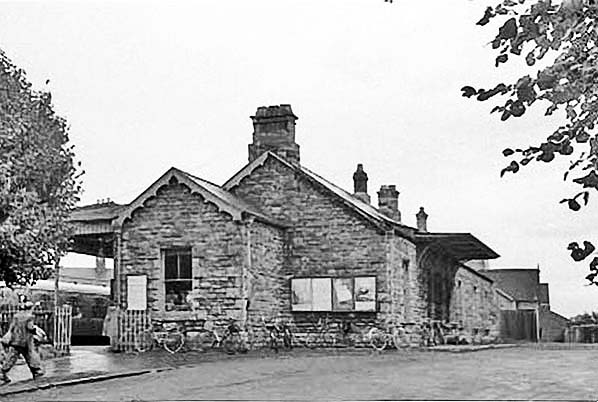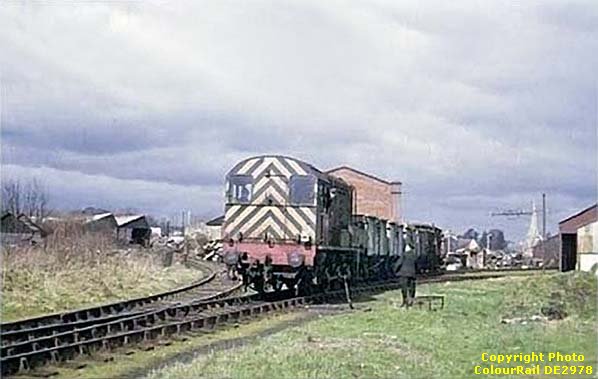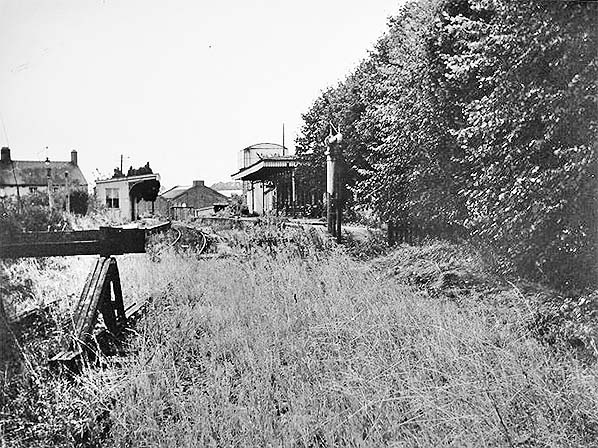
Station Name:CIRENCESTER WATERMOORold23.jpg) Passengers wait on the Down platform at Cirencester Watermoor while a train stands on the up platform on a wet day in September 1961. The photo is undated but the train might be the RCTS railtour of 10 September but could also be one of the last service trains the previous day.
Photo from John Mann collection  With the station building more resembling a goods shed, this is Watermoor's forecourt looking south. In the distance can be seen the stationmaster's house, by this time in use as offices, and beyond it the rear of the signal box. There is a train at the Down platform and the carriage visible is a BR Mk 1 apparently in maroon livery. This therefore dates the photograph to the 1956 - 1961 period. There is a large number of bicycles present, seemingly hastily parked, and the two people on the left appear very interested in the train. This might suggest the train was a special and could have been that hauled by 'Cookham Manor' on 10 September 1961. It will be noticed how the forecourt slopes gently up to the station building, giving away the fact the station was for all intents and purposes on a low embankment.
Photo from Duncan Chandler's Flickr Photostream watermoor_old28.jpg)
Looking south from Cirencester Watermoor towards South Cerney in 1963, a year before all traffic to Cirencester ceased. The main line, seen on the left, has been singled and has been lifted beyond Cirencester Watermoor station. Most of the Cirencester goods sidings are still in place, including the gasworks siding, but the only traffic but this time was probably scrap, a scrap dealer having taken over much of the yard. The gasworks seen on the right has been closed for many years and most of the windows have been bricked up. The chimney has been further truncated since 1961 (see picture above).The gasometer seen here continued in use for storage and compression.
Photo by Derek King 
Diesel Hauled freight services between Swindon and Cirencester continued until 31 March 1964. A class 08 Swindon based diesel shunter D4120 moves mineral wagons in the goods yard, adjacent to the former GWR works building on 25 Match 1964, a few days before closure. Scrap cars are seen in the background on both side of the works building. Scrap is likely to have been the only freight traffic by this time.
Copyright photo from ColourRail 
The desolate scene at the north end of Watermoor station, looking south, following track lifting north of Cirencester. The photograph is undated but will be around the time of total closure in 1964. On 11 September 1961 the section between Cirencester and Andoversford Junction closed completely. Track lifting on this section, Andoversford Junction excluded, began in March 1963 and had reached Cirencester in May of that year. The contract had been awarded to Messrs. Pittrail of Aldridge, Staffordshire, using a Ruston & Hornsby 88DS diesel shunter and a Ruston - Bucyrus 22-RB crawler crane, the latter being hired from Messrs. Charles Jones, also of Aldridge. The contractor's base was at Foss Cross, to where complete track panels were taken for dismantling and disposal. Lifting was undertaken first southwards to Foss Cross and then northwards thereto from Cirencester. In this view, track has been left in the Down platform as a siding and a bufferstop erected. The Down platform running-in board has gone, platform furniture removed and the signal box demolished. At least one gas light remains in situ as does the Up side water crane, the latter being redundant in March 1960. In the background the chimney of the former gasworks has been further reduced in height.
Photo from Paul Strong collection watermoor1.jpg)
Cirencester Watermoor station looking north c mid 1960s, shortly after the track was lifted. The stationmaster's house, used in later years as an office, is seen on the platform on the left.
Photo
from John Mann collection
watermoor2.jpg)
In August 1967 although the line had closed and the track had been lifted the scrap yard that occupied the goods yard and the former works had not yet encroached on the station which remained largely intact and was beginning to get overgrown. The main station building on the Up platform and shelter on the down platform are still in reasonable condition and haven't suffered from vandalism.
Photo by Nick Catford watermoor3.jpg)
Cirencester Watermoor down platform building, seen from the up platform in August 1967. Although the track has been lifted the ballast was still in place at this time. The stationmaster’s house is seen beyond the station building but the water tower and signal box have been demolished.
Photo by Nick Catford watermoor4.jpg) Cirencester Watermoor station looking south towards Cirencester Gasworks in August 1967.
Photo by Nick Catford  9.1967.jpg) Cirencester Watermoor station looking north from the up platform in September.1967 Cirencester Watermoor station looking north from the up platform in September.1967Photo
by Rowan Brockhurst
watermoor21.jpg) Cirencester Watermoor station approach c late 1960s facing south from Chesterton Lane. The now-defunct railway crossed the road on a bridge (154), out of view to the left. Watermoor station is in the background, directly ahead of the camera, while what is thought to be the goods shed can be seen in the right background. Some of the road vehicles present will be connected with the scrap dealer by this time occupying the site, otherwise the approach was apparently being used as a lorry park. On the left it would appear the driver of the Mk 1 Ford Cortina has just made a telephone call. Cirencester Watermoor station approach c late 1960s facing south from Chesterton Lane. The now-defunct railway crossed the road on a bridge (154), out of view to the left. Watermoor station is in the background, directly ahead of the camera, while what is thought to be the goods shed can be seen in the right background. Some of the road vehicles present will be connected with the scrap dealer by this time occupying the site, otherwise the approach was apparently being used as a lorry park. On the left it would appear the driver of the Mk 1 Ford Cortina has just made a telephone call.Photo by Dave Bushell from M&SWJR Odds and Ends web site watermoor14.jpg)
Cirencester Watermoor station forecourt, the north end of the up-side station building c late 1960s.
Photo by Dave Bushell from M&SWJR Odds and Ends web site watermoor16.jpg) The generous Cirencester Watermoor down platform waiting shelter c late 1960s. Some of the WWII anti-tank defences seen to the right of the shelter are still in place today. The generous Cirencester Watermoor down platform waiting shelter c late 1960s. Some of the WWII anti-tank defences seen to the right of the shelter are still in place today. Photo by Dave Bushell from M&SWJR Odds and Ends web site Click here for Cirencester Watermoor Gallery 5
 Home Page Home Page
|
